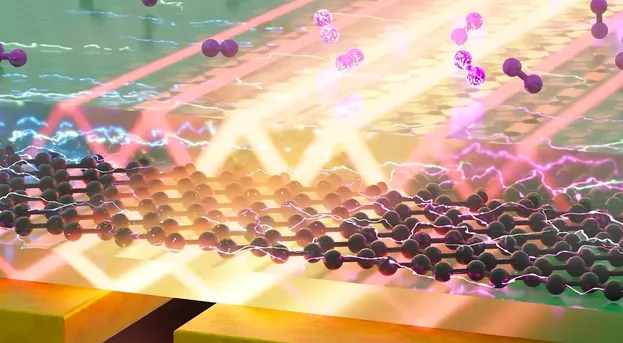
Revolutionary On-Chip Device Employs Exotic Light to Detect Molecules with Unprecedented Sensitivity!
2024-11-20
Author: Li
In a groundbreaking development, researchers have unveiled a state-of-the-art device designed to identify molecules using their unique infrared vibrational "fingerprints." This innovative detector, described in a recent edition of *Nature Communications*, allows for ultra-sensitive detection of molecules, opening the door for next-generation molecular and gas sensing applications that could transform various industries.
The Mechanism Behind the Device
At the core of this device is an ability to convert incoming infrared light into “nanolight” — a highly confined type of phonon polariton. This remarkable mechanism significantly enhances the sensitivity of the detector and amplifies the vibrational fingerprints of extremely thin molecular layers placed atop it. Think of it as a super-sleuthing technology, capable of identifying substances with incredible precision.
Unique Vibrational Characteristics of Molecules
Molecules possess distinct vibrational characteristics, akin to human fingerprints, which can be exploited to differentiate them. When exposed to specific infrared light frequencies, these molecules vibrate in unique ways. This characteristic resonance allows scientists to identify various substances or gases, even helping to detect potentially hazardous materials that often go unnoticed.
Challenges with Traditional Methods
Traditionally, infrared fingerprint spectroscopy has been employed for such tasks. However, the small size of organic molecules relative to infrared wavelengths results in weak signals that pose detection challenges. To overcome this, Surface-Enhanced Infrared Absorption (SEIRA) spectroscopy has emerged, which leverages the enhancements provided by rough metal surfaces to boost molecular signals—an essential step in studying minute materials.
Advancements in Phonon Polaritons
Excitingly, recent advancements in phonon polaritons—specifically, hyperbolic phonon polaritons found in thin layers of hexagonal boron nitride (h-BN)—have proven to be game-changers for SEIRA spectroscopy. Experts like Prof. Rainer Hillenbrand from Nanogune emphasize that these phonon polaritons can dramatically enhance sensitivity and precision in detecting nanometer-scale molecular vibrations.
Integration of Graphene-Based Detectors
Nonetheless, the conventional applications of SEIRA spectroscopy often require bulky, complicated equipment that limits portability and integration into modern technology. Fortunately, a collaborative team from Nanogune and ICFO has successfully integrated cutting-edge graphene-based infrared detectors that operate at room temperature with the principles of phonon polariton detection.
Potential Applications
This advancement not only streamlines the detection process but also eliminates the need for cumbersome infrared detectors traditionally used. ICFO researcher Dr. Sebastián Castilla highlights how this integration could lead to the creation of a revolutionary “lab-on-a-chip” technology, which allows for real-time identification of specific molecules in small liquid samples—a potential game-changer for medical diagnostics and environmental monitoring.
Future Prospects
The prospects extend even further. Dr. Andrei Bylinkin, a lead researcher in the study, envisions a future where these compact on-chip infrared detectors could be incorporated into smartphones or wearable tech, propelling rapid molecular identification into the mainstream. This innovation signals the dawn of a new era in portable sensing technology, capable of delivering sensitive and reliable spectroscopic analysis all while operating at room temperature.
Implications for Various Fields
As researchers continue to refine this technology, the implications for security, healthcare, and environmental safety are immense. The ability to swiftly identify dangerous substances, while also advancing precision in various applications, may soon transform our world as we know it. Stay tuned as we delve deeper into the potential of this groundbreaking technology!



 Brasil (PT)
Brasil (PT)
 Canada (EN)
Canada (EN)
 Chile (ES)
Chile (ES)
 España (ES)
España (ES)
 France (FR)
France (FR)
 Hong Kong (EN)
Hong Kong (EN)
 Italia (IT)
Italia (IT)
 日本 (JA)
日本 (JA)
 Magyarország (HU)
Magyarország (HU)
 Norge (NO)
Norge (NO)
 Polska (PL)
Polska (PL)
 Schweiz (DE)
Schweiz (DE)
 Singapore (EN)
Singapore (EN)
 Sverige (SV)
Sverige (SV)
 Suomi (FI)
Suomi (FI)
 Türkiye (TR)
Türkiye (TR)